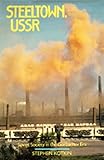Found in 2 comments on Hacker News
chiph · 2016-04-13
· Original
thread
If you'd like to learn more, this is a good book on Magnitogorsk during the Gorbachev years.
http://www.amazon.com/Steeltown-USSR-Soviet-Society-Gorbache...
It's really heartrending to read - all that talent and natural resources wasted just to say they met their planned quota.


https://www.amazon.com/Steeltown-USSR-Soviet-Society-Gorbach...
The factory was producing substandard steel. Often they'd ship it to customers and it would arrive in an unusable condition because it had been stored outside and was more rust than steel. But they'd try and use it anyway, because if they complained the bureaucrats in Moscow would brand them troublemakers and route the next shipment to someone else and then they wouldn't meet their production goals, which meant their pay would be drastically cut, and their family would starve.
Your "blue shirt vs. tan shirt" is absurdly simplistic, and makes enormous incorrect assumptions, like "Is there even a shirt there to buy that day?"
Some other reading for you would be about Krushchev's visit to the US in the 1950's. He visited a few supermarkets and assumed that they had been set up just for his visit (Potemkin villages) as that was what the Soviet Union would have done. Because having that much product on the shelves was absurd.
http://media3.washingtonpost.com/wp-srv/photo/gallery/090611...